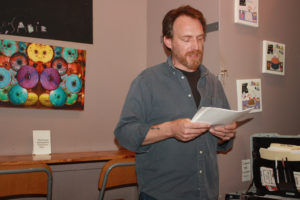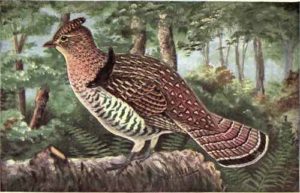(Naturalist, musician, and all around nice guy, Spider Barbour writes a nature column with Anita Barbour for the Woodstock Times. On Sunday afternoon, December 4th, he will join Michael Perkins and me for a reading at 1 pm at the Historical Society of Woodstock.)
It started with the March flood, a nameless precursor to Hurricane Irene, forgotten in her wake and Lee’s. Here in Saugerties that March flood was boosted by DEP’s first-of-the-year’s release of mud into the Esopus Creek. But we live several miles and a few hundred feet uphill from the Esopus, right across from the Beaver Kill, a notch down in size from the Esopus. During Irene’s weekend reign the Beaver Kill rose nearly to the level of Rt. 212, the road between the Beaver Kill and us.
There’s yet another stream, one that runs through our yard out of a vague groundwater source under quarry rubble a hundred yards or so in the woods south of our back line. This flow erupts to fill a vernal pool where Anita and I sometimes stroll to hear and see the wood frogs mating in March or April. The stream moves under more rubble for a hundred feet or so, then gathers over flat rocks, deepens and flows into our yard and through two stone-dammed ponds, back and front. In high water both ponds overspill. In addition to the overspill dam, the front pond has a culvert that feeds into a storm drain. This culvert moderates the pond level while the dam delays excess flow to the storm drain during floods.
This system of natural and artificial controls has worked well except in exceptional floods, or when the storm drains get clogged. Both occurred in that March flood.
The confluence of overflow from our swollen stream and excess runoff down Fishcreek Road gathered at the corner, where it formed a ten-foot wide, three-inch-deep riffle that spilled over Rt. 212 and into the Beaver Kill. When faced with this little torrent drivers responded in one of two ways, either by slowing down and gingerly fording the flow, or by blasting through it, spewing water higher than the hoods of their pickups.
Next sunny day the DOT crew arrived, heralded by tool clanking and harrumphing and cigar puffing, soon followed by the chugging, revving and scraping of the biggest front-end loader we’d ever seen outside of a Caterpillar commercial. Like the first yellowjacket out of the nest I leapt the porch steps just as the budding lilacs fell like toppling Douglas firs in that Caterpillar commercial.
“What are you doing?”
“We gotta let this water out!”
“With that thing? Where’s your back hoe?”
“Don’t have one.”
“What?? Come on, you have to!”
“They didn’t buy us one.”
“Didn’t buy you one????”
“Nope, this is what we got.”
“Well what about these lilacs?”
“Well waddya want? Somebody could have an accident and sue ya!”
“Look! You dropped the lilacs and an old elm stump on top of the storm drain!”
“Well, we’ll take care of that, don’t you worry.”
I repeated more calmly, “Well, can you set the lilacs back up?”
“Yeah, okay, when we come back.”
“When you come back? When will that be?”
“Don’t know. Couple days, next week maybe.”
Uh huh. The state guys came by once or twice, didn’t really do anything, just took a look and left. The day before Irene’s visit they stopped and dug out the gravel-filled ditch at the corner of Fishcreek and 212. Back in April the gravel bar in what was originally the ditch had been instrumental in whooshing stormwater over the road and into the Beaver Kill.
The day after the eyewall of Irene had come and gone we saw that the ditch was filled and topped off with a new load of gravel from washed out driveways and shoulders up Fishcreek Road, a small part of the hurricane’s gift of new work for our local road crews.





